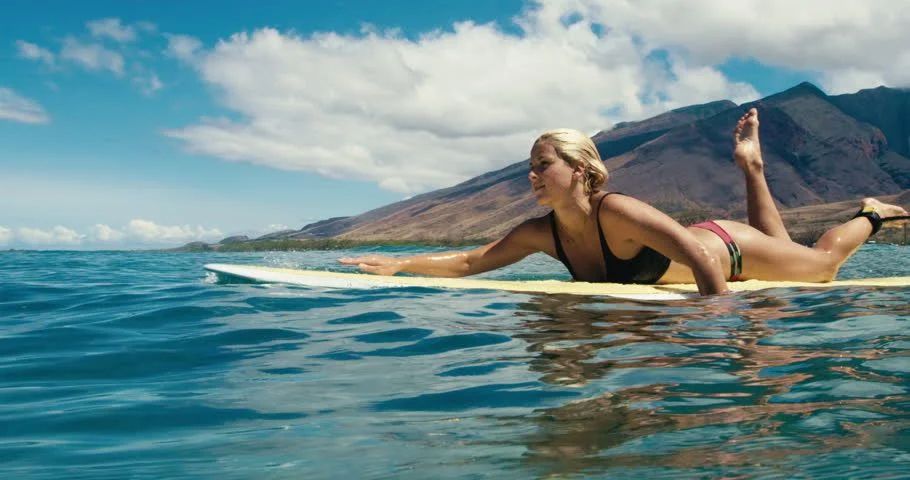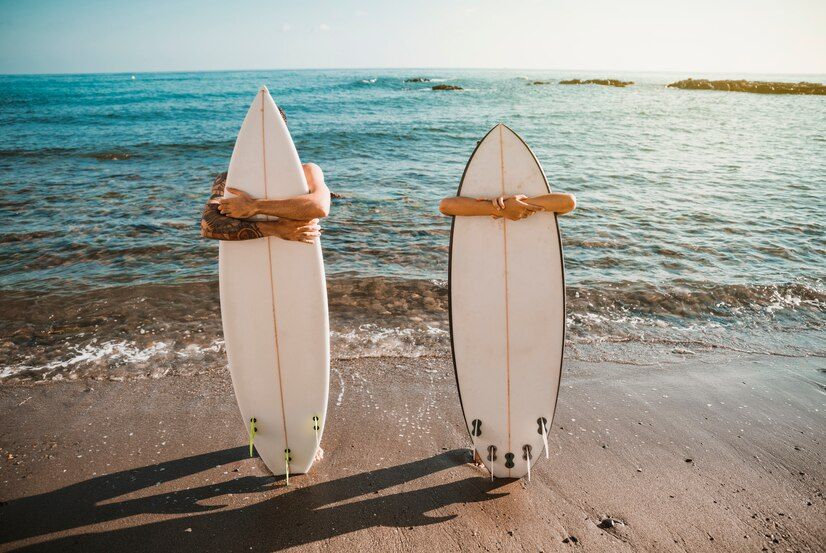Surfing, a blend of adventure and discipline, all is about respecting the sea, fellow surfers, and the sport itself. The surfing rules are often unspoken yet universally acknowledged and form the backbone of what is known as ‘surf etiquette.’ Whether you’re carving the waves like a pro or just starting to catch your first break, there’s one thing you can’t afford to miss – the basics of surf etiquette. The laid-back vibe of surfing can quickly turn dicey without following these rules, especially with today’s increasingly crowded lineups.
Don’t just be another surfer, be a responsible one. Surf confidently, respect the surfing lineup rules, and enjoy the thrill of surfing the right way!
1. Right of Way
It means that the surfer nearest to where the wave starts, known as the peak, gets the first chance to surf it. Hence, when you’re paddling out to catch a wave, always look around to see if someone is in a better spot to take it. If you find someone closer to the peak, you must back off and let them go. Avoid paddling around them or cutting in to take their wave because this is disrespectful and dangerous.
Here’s how to figure out who has the right to go first:
- Who’s Out Furthest: The surfer who is furthest out in the water or who has been waiting the longest usually gets to go first.
- Who’s Closest to the Peak: If you’re nearest to where the wave starts to break (the peak), you have the right to ride it.
- First Up, First Go: If someone gets up on their feet first, they get to take the wave.
- Talk It Out: If a wave can break left and right (dual-peaking), surfers might shout “Left!” or “Right!” to let others know which way they’re going.
If someone else has the right to a wave, let them have it. That way, everyone gets a turn and enjoys their time surfing.
2. Don’t Drop In
‘Dropping in’ happens when you take off on a wave that another surfer is already riding. It’s one of the most serious no-nos in basic rules of surfing. Simply put, if another surfer has already claimed a wave and is riding it, it is off-limits to everyone else. It’s about respecting the surfer’s space and ride. ‘Dropping in’ is akin to cutting someone off in traffic – not only does it spoil their experience, but it can also lead to dangerous collisions.

3. Paddling Rules
Paddlers need to avoid the path of other surfers. When you’re heading back out, always paddle around the area where waves are breaking. This prevents you from interfering with surfers who are catching waves, reducing the risk of collisions.
If you find yourself in the path of a surfer on a wave, the best approach is to paddle towards the whitewater. The idea here is to avoid the surfer’s line on the unbroken part of the wave.
Secondly, when paddling out, if you find yourself in a situation where you’re heading towards an oncoming surfer on a wave, the safest approach is to paddle towards the whitewater, not the unbroken wave face. Paddling towards the whitewater (the broken part of the wave) is generally safer and less disruptive because the surfer riding the wave is likely to be on the unbroken part.
4. Maintaining Control
Another important rule of surfing etiquette rules is always maintaining control of yourself and your board. Considering the day’s conditions, you need to be in tune with your surroundings and surf within your skill level. Avoid taking on waves that are too big or heading into areas that are packed with other surfers. Stick to spots that match your ability and stay clear of areas meant for other activities. Surfing when you’re exhausted, unwell, or under the influence of substances like alcohol or drugs is a definite no-no, as it weakens your safety and control.
5. Don’t Ditch Your Board
Letting go of your surfboard as a wave approaches, commonly known as ditching your board, is a habit that surfers should avoid. When you release your board, you lose control over it, creating a risk where it could strike someone else, potentially causing serious injuries.
Moreover, ditching your board exposes you to the full force of the wave, along with the risks posed by the reef or seabed. Such an act is often seen as a sign of carelessness and a disregard for the safety and respect of the surfing community. Most surfers need to learn and master techniques like duck diving or turtle rolling, which will help you manage waves safely while maintaining control of your board.

6. Respect Locals
Respecting local surfers involves more than just acknowledging their presence; it’s about valuing their deep understanding of the local surf environment. First and foremost, locals possess invaluable knowledge about the best spots and times for surfing, which can greatly enhance your experience. They are also aware of any potential risks, such as hidden rocks or strong currents, and their advice can save you from accidents. Additionally, respecting the unique culture and adapting to these norms shows your respect for the local surfing community and their home break.

7. No Snaking
Snaking happens when you paddle around or cut in front of someone already lined up for a wave. It’s a selfish move that breaks the rule of right of way. Doing this is rude and risky because it could lead to a crash or even a heated argument. If you snake, you’re pretty much asking for trouble and might end up with a bad argument among your fellow surfers. So, don’t be that person. The best thing to do is to chill, wait your turn, and stick to the lineup order.
8. Communicate
Good communication helps to avoid misunderstandings and potential conflicts among surfers. It can be as simple as making eye contact, using hand signals, or nodding your head. When you’re paddling out and eyeing a wave, make sure to let other surfers know your intentions. Are you going left or right or passing up the wave? Just as important is listening and responding to what others are signaling. Through communication, surfers can also point out hazards like rocks, potential shark presence, or rip currents. Hence, it’s a nice way to shout out, say sorry if you’ve made a mistake, or express thanks.

9. Help Others
When you help others, it shows you’re mindful of the safety and well-being of your fellow surfers. This could mean giving some surf safety tips or advice to those who are just starting out or less experienced. It’s also about being there for someone in a jam, maybe someone who’s injured, struggling in a rip current or having a tough time in the water. Sharing waves, offering spare equipment, or even a ride to the beach are all ways to lend a hand. Helping out not only feels great, but it also builds friendships and a sense of community among surfers.
10. Respect the Environment
Always leave the natural beauty of the spot just as you found it. Do not litter, and be mindful not to harm the local wildlife or plants. Try to minimize your water and energy usage. Avoid polluting the water or air, and be conscious of your impact on erosion and local ecosystems. It’s also good practice to steer clear of activities that are not eco-friendly. Every surfer can play a part in lessening their environmental footprint, supporting green initiatives, and spreading awareness about preserving our surf spots for future generations.
11. Don’t Surf Beyond Your Abilities
Areas designated for learning to surf deserve special attention. These zones are typically set up for beginners with smaller, more manageable waves. If you’re an experienced surfer, it’s considerate to give learners the space they need in these areas. This respect ensures a safe and encouraging environment for new surfers to develop their skills without feeling overwhelmed or intimidated.

12. Learning Area Respect
Areas designated for learning to surf deserve special attention. These zones are typically set up for beginners with smaller, more manageable waves. If you’re an experienced surfer, it’s considerate to give learners the space they need in these areas. Such respect will encourage new surfers to develop their skills without feeling overwhelmed or intimidated.
13. Apologize for Mistakes
Everyone makes mistakes, and in surfing, owning up to them is part of good etiquette. A simple apology can go a long way if you accidentally break a rule, like dropping in on someone’s wave or snaking. It helps maintain a friendly atmosphere in the water and shows that you’re responsible and respectful of the surfing community’s norms. Mistakes are part of learning, and acknowledging them helps everyone have a better time in the surf.

14. No Alcohol or Drugs
Regarding surfing rules and etiquette, steering clear of alcohol and drugs is a must for every surfer. These substances negatively impact judgment, coordination, and reaction time, which are vital for a safe surfing experience. Surfing under the influence can lead to dangerous decisions and a lack of control, posing risks to both you and others in the water. Additionally, it hampers your overall surfing performance, reducing alertness and endurance. Surfing with a clear mind shows respect for the sport and its culture.
15. Understand Surf Conditions
Understanding surf conditions is integral to surfing rules and etiquette. Knowing how tides, winds, swells, currents, and weather patterns influence waves is crucial for making informed decisions about where and when to surf, and which equipment to use. Being aware of potential surfing dangers like rip currents, shallow reefs, or unpredictable weather is vital for your safety. Additionally, adapting to changes in the surfing environment, like shifting wave patterns or crowded line-ups, enhances your safety and enjoyment of the sport. This awareness keeps you safe and deepens your connection with the ocean.

Keeping it Cool on the Waves by Following Surfing Rules
Surfing is about having fun and staying safe, and that’s where knowing the rules really helps. These surfing rules are like a friendly guide to ensure everyone gets along in the water. More than just avoiding mishaps, they’re about respecting fellow surfers and the beach. Everyone following the rules makes surfing a much more enjoyable experience. It’s like being part of a team where everyone has each other’s back.
Boost your surfing experience with Boost Fin, an electric fin that can be attached to any board within 5 minutes. It is made to transform how we ride the waves, offering both fun and a performance edge. Give Boost Fin a try and see how it changes your game. Grab one today, and let’s make every wave count with respect, enjoyment, and the advanced technology of Boost Fin.


Share:
How Long Does It Take to Learn to Surf?
Paddling in Surfing: How to Paddle On a Surfboard